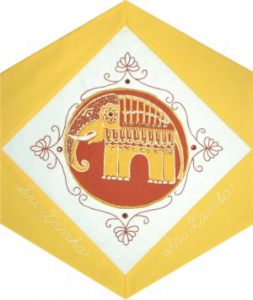Sri Lanka

The Block
Pauline Siva combined two of Sri Lanka’s traditional handcrafts, embroidery and batik, fabric produced using a resist dyeing technique. The dominant colours, gold and red, are widely used in clothing and are still favoured by Hindu brides. In the centre is a depiction of the endangered and officially protected Asian elephant, which has since ancient times been a cherished part of Sri Lankan culture.
Historically the property of royals, elephants have become an integral part of many national festivals, including the Kandy Esala Perahera. During this festival honouring the Dalada Maligawa, the Temple of the Tooth adorned with an antique elephant tusk, a replica of the shrine is carried through the city on an elephant. Sequins and faux jewels used to embellish the picture are typical of the gold and precious and semi-precious gems that bedeck these magnificent beasts as they parade through the streets. Elephants are also featured in shows at the Dehiwala Zoo, while the Sri Lankan New Year is celebrated, in part, with elephant races, and their images decorate temples throughout the country. Scrolled embroidery surrounding the elephant completes the piece.
Cultural Profile
Sri Lanka is a small tropical tear-shaped island off the coast of India that was connected to the mainland through a natural bridge. Passable on foot until 1480, the chain of sandbanks and limestone shoals was destroyed by a cyclone. The island was formerly known as Ceylon and ‘The Land of the Lion Kings,’ but in 1972 it assumed its ancient (and current) name, which is derived from the Sanskrit word meaning “resplendent land.” The population is comprised mainly of Sinhalese; the Tamils are the largest minority group. Sinhalese (Sinhala) and Tamil are the official languages, and English is the national language. Sri Lanka is known for being the first country to have a female Prime Minister, the late Sirimavo Bandaranaike, who assumed the position in 1960.
The country is known for its rich biodiversity: many of its plant and animal species cannot be found anywhere else. It also has a sparkling reputation for its magnificent gemstones, particularly blue sapphires. The Blue Giant of the Orient, the world’s largest faceted sapphire, weighing almost 500 carats, was found in the country’s gem gravels. The tea grown on the island is also world-renown, as is its cinnamon.
Sri Lankans express themselves artistically in many ways, including through such traditional handcrafts as coir products made from coconut husks, metalwork, pottery and weaving, particularly in the area of Dumbara. Lace making was also introduced by the Portuguese, and bobbin lace as well as needle lace is still produced. Mask-making is a major form of artistic expression that is used in the traditional dances or the folk drama known as the kolam. Music and dance, other important features of the culture, are often accompanied by drums, the national instrument, which in addition to marking important occasions, are used in some villages to transmit information.
Sri Lanka has had ties with Canada for many years. The road to Colombo Airport was built with the Canadian government’s help and is called “Canada-Sri Lanka Friendship Road.” Sri Lankans began immigrating here following World War II; many coming in search of employment and social opportunities. Most of those who had educational or professional qualifications and experience continued in managerial, technical or professional positions. The number of immigrants grew rapidly during the 1980s when thousands of refugees, fleeing civil unrest in their homeland, arrived in Canada. Many new arrivals settled in the urban areas of Ontario, while smaller groups contributed to the growth of Québec, Alberta and British Columbia urban communities. As of 2011, there were 140,000 Sri Lankans living in Canada. Some entered the entrepreneurial field by becoming grocers and restaurateurs (specializing in South Asian cuisine), as well as travel and real estate agents. Others, such as poet and writer Michael Ondaatje (The English Patient) and author Shyam Selvadurai (Funny Boy) have contributed their literary skills to Canadian society.
Sponsor: Faith Burgess and Pauline Siva, in memoriam Michael Siva
